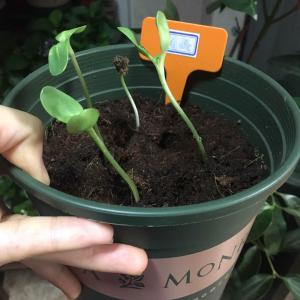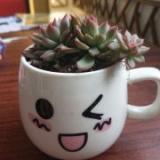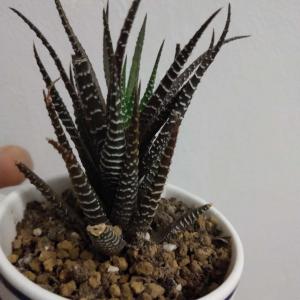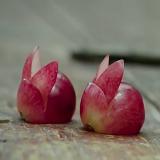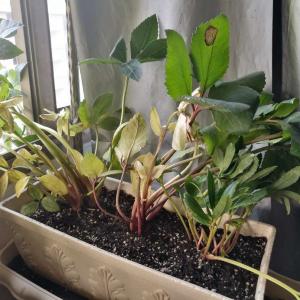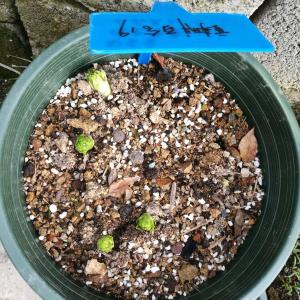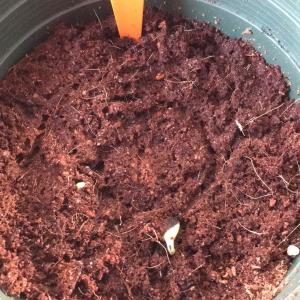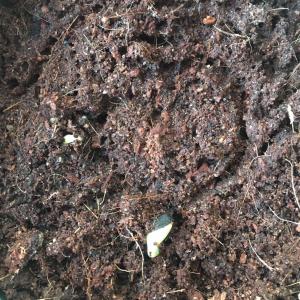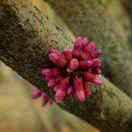成长记
MrsMissy3477
2018年05月15日

Day 4. Drizzled a bit of hydrogen peroxide on a tiny bit of fungal growth on surface of soil. Fixed it right up!

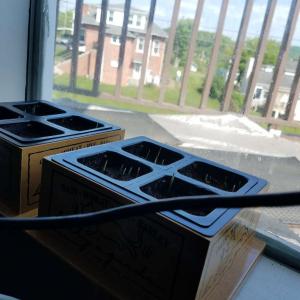


1
0
文章
权问薇
2018年05月14日


1、适时移栽
等到它有3到4片叶子长出时,可以找来一个16厘米口径大小的盆子将其移栽进去,盆土用腐叶土、菜园土、粗砂、草木灰等混配而成,以保证土壤的疏松性和排水性能。之后就可对其浇上透水,并放在较阴凉地养护,不可受阳光直射。

2、控制温度
等到霜降到来之后,即天气开始变冷时,如果你在北方,需要将它及时搬到温度较低的温室中,或者放在阳台上,并维持温度在10到20度之间,不可超过30度,不然,就会让叶片因为闷热变得发黄,这样根茎也较容易烂掉。同时,等到它到了现蕾时期,温度也应多加注意,最好将之控制在7到10度之间,这样可使花朵提前开放。

3、适当追肥
它极其喜肥,所以在养护的过程中,肥料对它很重要,应该每隔上一星期对其施加一次,肥料不仅使用有机肥,还要使用无机肥。在第一次施肥时,用鸡猪粪液肥最好,并保证浓度适当,第二次施肥时,以磷酸二氢钾为主,其浓度为3%,第三次施肥以无机肥料为主,这样轮流使用起来,可让花蕾早日开始分化。如果现蕾初期在春节前半个月,那它在春节即可开出花来。
4、适当舒蕾
在它刚出现花蕾时,应给它适当舒蕾,只留下3到5个健壮花蕾即可,这样就可让其花朵更大,观赏性也更佳。等到开花之后,还要及时将残花剪掉,防止营养流失,以让它开出更多花。

0
1
文章
Miss Chen
2018年05月13日

Description: This herbaceous plant is a biennial or short-lived perennial. During the first year, several basal leaves are produced, but thereafter this plant bolts to produce flowering stalks about 4-8' tall. The central stem is light green, stout, terete with vertical ridges, more or less covered with spreading white hairs, and usually unbranched. The interior of the this stem is hollow. Widely spreading alternate leaves are located primarily along the lower half of the central stem, becoming smaller in size above. The lower to middle alternate leaves are ternately compound (divided into 3 leaflets); they are 8-20" long and similarly across in outline. The leaflets are 4-12" long and ovate or orbicular in outline; they are shallowly to moderately cleft into 3-5 lobes and coarsely toothed. The lobes of leaflets are ovate in shape; they have broad acute tips. The upper leaflet surface is grayish green, medium green, or yellowish green and rough-textured, while the lower leaflet surface is slightly more pale and hairy along the primary and secondary veins. The petioles of lower to middle leaves are 3-10" long, light green, hairy, and relatively stout (especially at the base). The petiole bases are partially enclosed by a pair of hairy membranous sheaths. These sheaths are light green, purplish green, or nearly white from abundant hairs. Upper leaves are usually simple, ternately lobed, and coarsely toothed; they are up to 4" long and similarly across. The lobes of upper leaves are lanceolate with acute tips. The upper leaves have petioles up to 2" long.
The central stem terminates in a compound umbel up to 8" across. Additional compound umbels are produced from the axils of upper leaves on long peduncles (flowering stalks); these axillary umbels are up to 6" across. The compound umbels are more or less flat-headed. Each compound umbel has 8-30 rays that terminate in umbellets; each umbellet has 8-30 flowers. The rays of the compound umbels are 2-5" long, light green, and pubescent; the pedicels of the flowers are ¼–¾" long, light green, and pubescent. Individual flowers span a little less than ¼" across. Each flower has a light green calyx that is shaped like a saucer, 5 white petals, 5 stamens, and a whitish ovary with a pair of tiny styles. The petals are strongly incurved at their tips. The blooming period occurs from late spring to mid-summer, lasting about 1 month. Afterwards, the flowers are replaced by fruits (schizocarps); each fruit consists of a pair of seeds. Individual immature fruits are about 8 mm. (1/3") in length, 6 mm. (1/4") across, and somewhat flattened; they are elliptic-obovoid in shape, light green with white margins, and there are 4 vertical dark green veins toward the center of each flattened side. Mature fruits become tan to dark brown, and their lateral margins become flattened into wings; they are distributed to a limited extent by the wind before dividing into seeds. The root system consists of a taproot or a cluster of thick roots. This plant reproduces by reseeding itself.

Cultivation: The preference is full sun to light shade, moist conditions, and fertile soil containing loam, silty loam, or sandy loam. The size of individual plants can vary considerably. Some protection from strong wind is desirable. Because Cow Parsnip can irritate human skin, it is best to wear gloves while handling its foliage.
Range & Habitat: The native Cow Parsnip is occasional in central and northern Illinois, while in the southern section of the state it is uncommon (see Distribution Map). Habitats include bottomland woodlands, terraces of floodplain woodlands, borders of woodlands, woodland openings, meadows in wooded areas, riverside prairies, thickets, streambanks, and partially shaded roadsides. Cow Parsnip can be found in both high quality natural areas and disturbed habitats.

Faunal Associations: The flowers of Cow Parsnip attract a large diversity of insects because of its easily accessed nectar and pollen. These floral visitors include honeybees, cuckoo bees (Nomada spp., Sphecodes spp.), plasterer bees (Colletes spp.), masked bees (Hylaeus spp.), Andrenid bees, Halictid bees, Sphecid wasps, Vespid wasps, spider wasps (Anoplius spp., etc.), Tiphiid wasps, Ichneumonid wasps, dark-winged fungus gnats (Sciara spp.), soldier flies (Stratiomys spp., etc.), Syrphid flies, dance flies (Empis spp., Rhamphomyia spp.), Tachinid flies, flesh flies (Ravinia spp., Sarcophaga spp., etc.), blow flies (Lucilia spp., etc.), Muscid flies, frit flies (Liohippelates spp., Olcella spp.), long-horned beetles (Strangalepta spp., Trigonarthris spp., etc.), tumbling flower beetles (Mordellidae), flower chafers (Trichiotinus spp., etc.), plant bugs (Miridae), and occasional butterflies (Robertson, 1929; Gosling, 1986). Some insects feed destructively on the foliage, fruit, and sap of cow parsnip. These insect feeders include the larvae of leaf-mining flies (Phytomyza spp., etc.), larvae of Euleia heraclei (Hogweed Picture-wing Fly), larvae of Depressaria pastinacella (Parsnip Webworm Moth), Orthops scutellatus (Carrot Plant Bug), Taeniothrips vulgatissima (Cow Parsnip Thrips), and such aphids as Aphis decepta, Cavariella aegopodii (Willow-Carrot Aphid), Cavariella pastinacae (Willow-Umbellifer Aphid), and Cavariella theobaldi (Willow-Parsnip Aphid); see Needham et al. (1928), Knight (1941), Stannard (1968), and Blackman & Eastop (2013). Some mammals feed on the flowers and foliage of Cow Parsnip, particularly in the western United States. There are records of bears, elk, deer, cattle, horses, and sheep feeding on this plant (Esser, 1995). However, when this plant is exposed to the ultraviolet radiation of sunlight, the foliage can become phytotoxic, causing blisters to form on the skin and possible irritation of the digestive tract (Georgia, 1913). This toxic side effect is the result of light-sensitive furanocoumarins. Cow Parsnip shares this characteristic with another species in the Carrot family, Pastinaca sativa (Parsnip).

Photographic Location: Border of a woodland along a road at Illinois Beach State Park in NE Illinois.
Comments: Because of the large size of its compound umbels, Cow Parsnip is one of the best sources of nectar and pollen for a wide variety of insects, especially small bees, wasps, flies, and beetles. This plant can be distinguished from other species in the Carrot family primarily by its large size (up to 8' tall or more), large ternately divided leaves, and hairy foliage. Other scientific names of Cow Parsnip include Heracleum lanatum and Heracleum sphondylium montanum. The latter scientific name, Heracleum sphondylium, refers to European Cow Parsnip. This plant species has compound leaves with 3-7 pinnately arranged leaflets, while the Cow Parsnip of North America, Heracleum maximum, has only 3 leaflets per compound leaf. Both plant species are about the same size. A third species that is native to Eurasia, but has naturalized in parts of North America, is Heracleum mantegazzianum, or Giant Hogweed. This is a much larger plant that becomes 6-18' tall at maturity. The compound leaves of Giant Hogweed are also larger in size than the preceding plant species in its genus; they are pinnate-pinnatifid or pinnate-bipinnatifid with narrowly acute lobes.
The central stem terminates in a compound umbel up to 8" across. Additional compound umbels are produced from the axils of upper leaves on long peduncles (flowering stalks); these axillary umbels are up to 6" across. The compound umbels are more or less flat-headed. Each compound umbel has 8-30 rays that terminate in umbellets; each umbellet has 8-30 flowers. The rays of the compound umbels are 2-5" long, light green, and pubescent; the pedicels of the flowers are ¼–¾" long, light green, and pubescent. Individual flowers span a little less than ¼" across. Each flower has a light green calyx that is shaped like a saucer, 5 white petals, 5 stamens, and a whitish ovary with a pair of tiny styles. The petals are strongly incurved at their tips. The blooming period occurs from late spring to mid-summer, lasting about 1 month. Afterwards, the flowers are replaced by fruits (schizocarps); each fruit consists of a pair of seeds. Individual immature fruits are about 8 mm. (1/3") in length, 6 mm. (1/4") across, and somewhat flattened; they are elliptic-obovoid in shape, light green with white margins, and there are 4 vertical dark green veins toward the center of each flattened side. Mature fruits become tan to dark brown, and their lateral margins become flattened into wings; they are distributed to a limited extent by the wind before dividing into seeds. The root system consists of a taproot or a cluster of thick roots. This plant reproduces by reseeding itself.

Cultivation: The preference is full sun to light shade, moist conditions, and fertile soil containing loam, silty loam, or sandy loam. The size of individual plants can vary considerably. Some protection from strong wind is desirable. Because Cow Parsnip can irritate human skin, it is best to wear gloves while handling its foliage.
Range & Habitat: The native Cow Parsnip is occasional in central and northern Illinois, while in the southern section of the state it is uncommon (see Distribution Map). Habitats include bottomland woodlands, terraces of floodplain woodlands, borders of woodlands, woodland openings, meadows in wooded areas, riverside prairies, thickets, streambanks, and partially shaded roadsides. Cow Parsnip can be found in both high quality natural areas and disturbed habitats.

Faunal Associations: The flowers of Cow Parsnip attract a large diversity of insects because of its easily accessed nectar and pollen. These floral visitors include honeybees, cuckoo bees (Nomada spp., Sphecodes spp.), plasterer bees (Colletes spp.), masked bees (Hylaeus spp.), Andrenid bees, Halictid bees, Sphecid wasps, Vespid wasps, spider wasps (Anoplius spp., etc.), Tiphiid wasps, Ichneumonid wasps, dark-winged fungus gnats (Sciara spp.), soldier flies (Stratiomys spp., etc.), Syrphid flies, dance flies (Empis spp., Rhamphomyia spp.), Tachinid flies, flesh flies (Ravinia spp., Sarcophaga spp., etc.), blow flies (Lucilia spp., etc.), Muscid flies, frit flies (Liohippelates spp., Olcella spp.), long-horned beetles (Strangalepta spp., Trigonarthris spp., etc.), tumbling flower beetles (Mordellidae), flower chafers (Trichiotinus spp., etc.), plant bugs (Miridae), and occasional butterflies (Robertson, 1929; Gosling, 1986). Some insects feed destructively on the foliage, fruit, and sap of cow parsnip. These insect feeders include the larvae of leaf-mining flies (Phytomyza spp., etc.), larvae of Euleia heraclei (Hogweed Picture-wing Fly), larvae of Depressaria pastinacella (Parsnip Webworm Moth), Orthops scutellatus (Carrot Plant Bug), Taeniothrips vulgatissima (Cow Parsnip Thrips), and such aphids as Aphis decepta, Cavariella aegopodii (Willow-Carrot Aphid), Cavariella pastinacae (Willow-Umbellifer Aphid), and Cavariella theobaldi (Willow-Parsnip Aphid); see Needham et al. (1928), Knight (1941), Stannard (1968), and Blackman & Eastop (2013). Some mammals feed on the flowers and foliage of Cow Parsnip, particularly in the western United States. There are records of bears, elk, deer, cattle, horses, and sheep feeding on this plant (Esser, 1995). However, when this plant is exposed to the ultraviolet radiation of sunlight, the foliage can become phytotoxic, causing blisters to form on the skin and possible irritation of the digestive tract (Georgia, 1913). This toxic side effect is the result of light-sensitive furanocoumarins. Cow Parsnip shares this characteristic with another species in the Carrot family, Pastinaca sativa (Parsnip).

Photographic Location: Border of a woodland along a road at Illinois Beach State Park in NE Illinois.
Comments: Because of the large size of its compound umbels, Cow Parsnip is one of the best sources of nectar and pollen for a wide variety of insects, especially small bees, wasps, flies, and beetles. This plant can be distinguished from other species in the Carrot family primarily by its large size (up to 8' tall or more), large ternately divided leaves, and hairy foliage. Other scientific names of Cow Parsnip include Heracleum lanatum and Heracleum sphondylium montanum. The latter scientific name, Heracleum sphondylium, refers to European Cow Parsnip. This plant species has compound leaves with 3-7 pinnately arranged leaflets, while the Cow Parsnip of North America, Heracleum maximum, has only 3 leaflets per compound leaf. Both plant species are about the same size. A third species that is native to Eurasia, but has naturalized in parts of North America, is Heracleum mantegazzianum, or Giant Hogweed. This is a much larger plant that becomes 6-18' tall at maturity. The compound leaves of Giant Hogweed are also larger in size than the preceding plant species in its genus; they are pinnate-pinnatifid or pinnate-bipinnatifid with narrowly acute lobes.
0
0
文章
Miss Chen
2018年05月13日

Description: This wildflower is a summer annual about 4-12" tall that is branched or unbranched. The stems are light green, terete, and pubescent. The opposite leaves are about 1" long and ¼" across; they are elliptic, oblong-lanceolate, or oblong-oblanceolate in shape. The margins of the leaves are smooth or they have a few blunt teeth toward their tips. The petioles of the leaves are short and slender. The foliage of American Pennyroyal has a strong medicinal-mint scent. Small axillary clusters of 1-4 flowers are produced from the base of each middle to upper leaf. Each flower is about ¼" long and half as much across, consisting of a 2-lipped tubular corolla, a tubular calyx with 5 teeth, 2 stamens, and a 4-celled ovary with a single style. The corolla is white or blue-violet with a contrasting color near its throat. Along the outer rim of the corolla, there is an upper lobe, 2 lateral lobes, and a lower lobe; they are short and rounded (although not always well-defined). The hairy ridged calyx has 3 upper triangular teeth and 2 lower teeth that are slender-lanceolate. At the base of each flower, there is a pair of a leafy bracts; these bracts are at least as long as the flower. The blooming period occurs from mid-summer to early fall and lasts 1-3 months; individual flowers are short-lived. At maturity, each fertile flower is replaced by 4 nutlets. This wildflower reproduces by reseeding itself. It occasionally forms colonies at favorable sites.
Cultivation: The preference is full sun to light shade, mesic to dry conditions, and soil that is rocky or loamy. Plants that are grown in sunny locations require more moisture than those growing in shade. Barren or disturbed locations that are largely devoid of ground vegetation are preferred, as this reduces competition from taller plants.
Range & Habitat: The native American Pennyroyal is occasional to locally common throughout Illinois, except the NW section of the state, where it is less common (see Distribution Map). Habitats include dry upland woodlands, rocky woodlands, areas along woodland trails, rocky glades, areas along railroads, roadsides, pastures, and fallow fields. This species prefers areas (whether sunny or shaded) that have been subjected to some disturbance.
Faunal Associations: Small bees pollinate the flowers, where they seek nectar and pollen. These visitors include little carpenter bees (Ceratina spp.), Halictid bees (Augochlorella spp., Halictus spp., & Lasioglossum spp.), and the dagger bee Calliopsis andreniformis. Syrphid flies may visit the flowers occasionally, but they feed on the pollen and are less effective at pollination. The strong scent of the foliage protects this plant from mammalian herbivores.

Photographic Location: An upland area of Busey Woods in Urbana, Illinois.
Comments: The most remarkable thing about this little plant is the strong scent of the foliage. Otherwise, it is rather easy to overlook. The only other species in this genus that occurs in Illinois, Hedeoma hispida (Rough Pennyroyal), has linear leaves and a milder scent; it also prefers sunnier habitats. American Pennyroyal superficially resembles Gratiola neglecta (Clammy Hedge Hyssop), but this latter species lacks any fragrance and its prefers soggy habitats (e.g., damp depressions in woodlands). Native pennyroyal species (Hedeoma spp.) have only 2 stamens per flower, while other similar species in the Mint family often have 4 stamens per flower. Because the flowers are so small, this requires a 10x hand lens to see clearly.
Cultivation: The preference is full sun to light shade, mesic to dry conditions, and soil that is rocky or loamy. Plants that are grown in sunny locations require more moisture than those growing in shade. Barren or disturbed locations that are largely devoid of ground vegetation are preferred, as this reduces competition from taller plants.
Range & Habitat: The native American Pennyroyal is occasional to locally common throughout Illinois, except the NW section of the state, where it is less common (see Distribution Map). Habitats include dry upland woodlands, rocky woodlands, areas along woodland trails, rocky glades, areas along railroads, roadsides, pastures, and fallow fields. This species prefers areas (whether sunny or shaded) that have been subjected to some disturbance.
Faunal Associations: Small bees pollinate the flowers, where they seek nectar and pollen. These visitors include little carpenter bees (Ceratina spp.), Halictid bees (Augochlorella spp., Halictus spp., & Lasioglossum spp.), and the dagger bee Calliopsis andreniformis. Syrphid flies may visit the flowers occasionally, but they feed on the pollen and are less effective at pollination. The strong scent of the foliage protects this plant from mammalian herbivores.

Photographic Location: An upland area of Busey Woods in Urbana, Illinois.
Comments: The most remarkable thing about this little plant is the strong scent of the foliage. Otherwise, it is rather easy to overlook. The only other species in this genus that occurs in Illinois, Hedeoma hispida (Rough Pennyroyal), has linear leaves and a milder scent; it also prefers sunnier habitats. American Pennyroyal superficially resembles Gratiola neglecta (Clammy Hedge Hyssop), but this latter species lacks any fragrance and its prefers soggy habitats (e.g., damp depressions in woodlands). Native pennyroyal species (Hedeoma spp.) have only 2 stamens per flower, while other similar species in the Mint family often have 4 stamens per flower. Because the flowers are so small, this requires a 10x hand lens to see clearly.
0
0
文章
Miss Chen
2018年05月13日

Description: This biennial plant forms a rosette of leaves during the first year. During the second year, it becomes a rather lanky plant about 2-4' tall that branches occasionally. The stems have abundant white hairs; the lower central stem is often ribbed. The basal and lower leaves are up to 6" long and 3½" across; they are cordate-ovate or ovate with petioles up to 2" long. The upper leaves are lanceolate to elliptic and sessile, otherwise they are similar to the lower leaves. All leaves have smooth (entire) and slightly ciliate margins. The upper leaf surface is dark green and sparsely covered with short stiff hairs, while the lower leaf surface is medium green and more hairy, especially along the major veins. Both the lower and upper leaves alternate along the stems. The upper stems terminate in flowering racemes about 4-12" long; sometimes shorter racemes or individual flowers develop from the axils of the upper leaves. The stalks (peduncles) of these racemes are pubescent or hairy, and small leafy bracts may develop underneath some of the flowers. The pedicels of the flowers are pubescent or hairy and up to ¼" (6 mm.) in length.
Each flower is about 1/8" (3 mm.) across, consisting of 5 petals and a pubescent green calyx with 5 slender teeth. The petals are white and well-rounded; less often, they are light blue. The blooming period occurs during the summer, lasting about 2-3 months. Only a few flowers are in bloom at the same time and they are fairly inconspicuous. The flowers are replaced by prickly subgloboid fruits (about 4-6 mm. across) that hang downward from short slender pedicels (one fruit per flower). Hooked prickles densely cover the surfaces of these fruits. The fruits are initially whitish green, but later they later become brown. Each fruit contains 4 nutlets. The root system consists of a taproot. This plant spreads by reseeding itself; it occasionally forms colonies.

Cultivation: The preference is partial sun to medium shade, mesic conditions, and a fertile loamy soil. However, this plant tolerates different kinds of soil and moisture conditions and it is quite adaptable.
Range & Habitat: The native Stickseed is common in central and northern Illinois, and locally common to absent in the southern section of the state (see Distribution Map). Habitats include moist to slightly dry deciduous woodlands, woodland borders, powerline clearances in wooded areas, thickets, and shady fence rows. Stickseed prefers disturbed wooded areas and it is rather weedy. This plant sometimes occurs in wooded areas where there has been a recent fire, as well as degraded wooded areas that are subjected to occasional grazing by cattle.

Faunal Associations: The nectar of the flowers attracts Halictid bees (Halictus spp., Lasioglossum spp.) and Syrphid flies, particularly Syritta pipiens. A flea beetle, Longitarsus melanurus, feeds on the leaves of Stickseed and other members of the Borage family. The bitter foliage is avoided by deer and other mammalian herbivores. When there is an overpopulation of deer in wooded areas, Stickseed often becomes more common. The bur-covered fruits can cling to the fur of mammals and clothing of humans; by this means, they are introduced into new areas.
Photographic Location: Edge of a wooded area at Busey Woods in Urbana, Illinois.

Comments: This is another woodland wildflower with small white flowers that blooms during the summer in shaded areas. The most distinctive characteristic of Stickseed (Hackelia virginiana) are the prickly fruits that hang downward from its slender racemes. Another species in the Borage family, European Stickseed (Lappula squarrosa), has similar racemes of prickly fruits. However, the prickles of its fruits are arranged in columns with spaces in-between. In contrast, the fruits of Stickseed are densely covered with prickles throughout. European Stickseed is shorter than Stickseed and its leaves are more slender. This introduced species prefers sunny areas, while the native Stickseed prefers wooded areas with some shade. An older scientific name for Stickseed is Lappula virginiana.
Each flower is about 1/8" (3 mm.) across, consisting of 5 petals and a pubescent green calyx with 5 slender teeth. The petals are white and well-rounded; less often, they are light blue. The blooming period occurs during the summer, lasting about 2-3 months. Only a few flowers are in bloom at the same time and they are fairly inconspicuous. The flowers are replaced by prickly subgloboid fruits (about 4-6 mm. across) that hang downward from short slender pedicels (one fruit per flower). Hooked prickles densely cover the surfaces of these fruits. The fruits are initially whitish green, but later they later become brown. Each fruit contains 4 nutlets. The root system consists of a taproot. This plant spreads by reseeding itself; it occasionally forms colonies.

Cultivation: The preference is partial sun to medium shade, mesic conditions, and a fertile loamy soil. However, this plant tolerates different kinds of soil and moisture conditions and it is quite adaptable.
Range & Habitat: The native Stickseed is common in central and northern Illinois, and locally common to absent in the southern section of the state (see Distribution Map). Habitats include moist to slightly dry deciduous woodlands, woodland borders, powerline clearances in wooded areas, thickets, and shady fence rows. Stickseed prefers disturbed wooded areas and it is rather weedy. This plant sometimes occurs in wooded areas where there has been a recent fire, as well as degraded wooded areas that are subjected to occasional grazing by cattle.

Faunal Associations: The nectar of the flowers attracts Halictid bees (Halictus spp., Lasioglossum spp.) and Syrphid flies, particularly Syritta pipiens. A flea beetle, Longitarsus melanurus, feeds on the leaves of Stickseed and other members of the Borage family. The bitter foliage is avoided by deer and other mammalian herbivores. When there is an overpopulation of deer in wooded areas, Stickseed often becomes more common. The bur-covered fruits can cling to the fur of mammals and clothing of humans; by this means, they are introduced into new areas.
Photographic Location: Edge of a wooded area at Busey Woods in Urbana, Illinois.

Comments: This is another woodland wildflower with small white flowers that blooms during the summer in shaded areas. The most distinctive characteristic of Stickseed (Hackelia virginiana) are the prickly fruits that hang downward from its slender racemes. Another species in the Borage family, European Stickseed (Lappula squarrosa), has similar racemes of prickly fruits. However, the prickles of its fruits are arranged in columns with spaces in-between. In contrast, the fruits of Stickseed are densely covered with prickles throughout. European Stickseed is shorter than Stickseed and its leaves are more slender. This introduced species prefers sunny areas, while the native Stickseed prefers wooded areas with some shade. An older scientific name for Stickseed is Lappula virginiana.
0
0
Finncarter
2018年05月13日

Lithops Olivecea, know as the living stone has annual (white daisy) likd flowers - for up to 3 weeks. These slow growing succulents produce lovley patterns on the top. they need to be watered every 4-6 weeks. @GFinger #Lithops ##Pattern ##Livingstones #Daisy
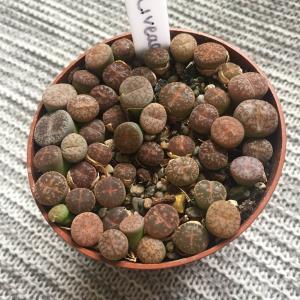

1
0
文章
Miss Chen
2018年05月12日

Description: This perennial wildflower is 4-20" tall at maturity, developing weak branching stems that have a tendency to lean on adjacent vegetation as they become longer. These stems are light green, angular, and branched; their edges are either smooth or slightly rough from short bristly hairs. Along the stems, there are whorls of mostly 6 leaves; often there are whorls of 4 leaves immediately below the cymes or panicles of flowers. Individual leaves are up to ¾" long and 1/8" (3 mm.) across; they are linear-elliptic in shape with short bristly hairs along their margins. The upper leaf surface is medium to dark green, hairless, and shiny. The leaves are sessile at their bases, while their tips are either blunt or acute.
The upper stems terminate in either small cymes or large panicles of flowers; the size of an inflorescence is variable depending on the size of the plant and environmental conditions. Each inflorescence is abundantly branched, terminating in groups of 2-3 flowers on short divergent pedicels. The pedicels of the flowers are light green, angular, and hairless. Each flower is about 1/8" across or a little less, consisting of a white corolla with 4 pointed lobes, 4 stamens, 2 styles, and a 2-celled ovary that is without bristles. Each cell of the ovary is globoid-ovoid in shape and joined together with the other cell along one side. The blooming period occurs during early summer, lasting about 2-3 weeks. The flowers are later replaced with smooth 2-celled fruits that change color from light green to purple and finally brown. Each cell of the fruit usually contains a single seed (or sometimes none). The root system is fibrous and rhizomatous. Small colonies of plants often develop from the rhizomes.

Cultivation: The preference is medium shade to dappled sunlight, mesic to dry conditions, and soil containing loam, clay-loam, sand, or rocky material with decaying organic matter. This bedstraw is more tolerant of dry conditions than most species in its genus. It could be cultivated as a ground cover underneath trees.
Range & Habitat: The native Shining Bedstraw is common throughout Illinois (see Distribution Map). Habitats include rich mesic woodlands, upland woodlands, open rocky woodlands, sandy woodlands, upper slopes and tops of bluffs, shaded cliffs, and woodland edges. Generally, this bedstraw is found in upland wooded areas where deciduous trees, especially oaks, are present.
Faunal Associations: The small flowers are cross-pollinated by small bees and flies, including Masked bees (Hylaeus spp.), Halictid bees (Lasioglossum spp.), and Syrphid flies. These insects suck nectar from the flowers. Other insects feed on the foliage, flower tissue, or plant juices of Galium spp. (bedstraws). These insect feeders include the caterpillars of such moths as Epirrhoe alternata (White-Banded Toothed Carpet), Lobocleta ossularia (Drab Brown Wave), and Hyles gallii (Galium Sphinx). Another insect, Myzus cerasi (Black Cherry Aphid), uses bedstraws as summer host plants. Because the stiff bristly hairs of the leaves can cling to passing objects, animals may play a minor role in distributing the seeds to new locations.
Photographic Location: The photographs were taken at a wooded bluff in east-central Illinois and the edge of a sandy woodland in NW Indiana.
Comments: Shining Bedstraw can be identified by its attractive shiny leaves in whorls of 6, its smooth fruits, and its preference for upland wooded locations.
The upper stems terminate in either small cymes or large panicles of flowers; the size of an inflorescence is variable depending on the size of the plant and environmental conditions. Each inflorescence is abundantly branched, terminating in groups of 2-3 flowers on short divergent pedicels. The pedicels of the flowers are light green, angular, and hairless. Each flower is about 1/8" across or a little less, consisting of a white corolla with 4 pointed lobes, 4 stamens, 2 styles, and a 2-celled ovary that is without bristles. Each cell of the ovary is globoid-ovoid in shape and joined together with the other cell along one side. The blooming period occurs during early summer, lasting about 2-3 weeks. The flowers are later replaced with smooth 2-celled fruits that change color from light green to purple and finally brown. Each cell of the fruit usually contains a single seed (or sometimes none). The root system is fibrous and rhizomatous. Small colonies of plants often develop from the rhizomes.

Cultivation: The preference is medium shade to dappled sunlight, mesic to dry conditions, and soil containing loam, clay-loam, sand, or rocky material with decaying organic matter. This bedstraw is more tolerant of dry conditions than most species in its genus. It could be cultivated as a ground cover underneath trees.
Range & Habitat: The native Shining Bedstraw is common throughout Illinois (see Distribution Map). Habitats include rich mesic woodlands, upland woodlands, open rocky woodlands, sandy woodlands, upper slopes and tops of bluffs, shaded cliffs, and woodland edges. Generally, this bedstraw is found in upland wooded areas where deciduous trees, especially oaks, are present.
Faunal Associations: The small flowers are cross-pollinated by small bees and flies, including Masked bees (Hylaeus spp.), Halictid bees (Lasioglossum spp.), and Syrphid flies. These insects suck nectar from the flowers. Other insects feed on the foliage, flower tissue, or plant juices of Galium spp. (bedstraws). These insect feeders include the caterpillars of such moths as Epirrhoe alternata (White-Banded Toothed Carpet), Lobocleta ossularia (Drab Brown Wave), and Hyles gallii (Galium Sphinx). Another insect, Myzus cerasi (Black Cherry Aphid), uses bedstraws as summer host plants. Because the stiff bristly hairs of the leaves can cling to passing objects, animals may play a minor role in distributing the seeds to new locations.
Photographic Location: The photographs were taken at a wooded bluff in east-central Illinois and the edge of a sandy woodland in NW Indiana.
Comments: Shining Bedstraw can be identified by its attractive shiny leaves in whorls of 6, its smooth fruits, and its preference for upland wooded locations.
0
0



